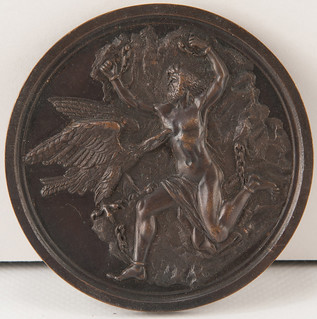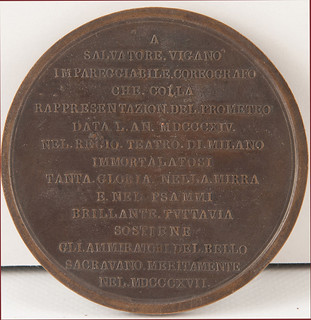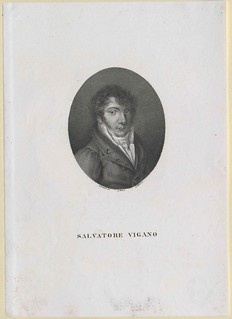
PREV ARTICLE
NEXT ARTICLE
FULL ISSUE
PREV FULL ISSUE
SALVATORE VIGANO MEDALAt my request book dealer Gil Parsons kindly provided this medal description from the anniversary catalog of his firm Parsons Books. Thanks. The full text is available from him - I had to cut out a good bit of interesting material due to space constraints. In earlier articles we looked at rare works by banknote maker Waterman Lilly Ormsby. This week we look at a medal relating to the composer Beethoven. The portait of Salvatore Vigano is courtesy Oesterreichische Nationalbibliothek Bildarchiv. -Editor


In 1801 in Imperial Vienna, under the direct patronage of Maria-Theresa, the renowned choreographer Salvatore Vigano (whose first ballet was in Venice 1791 and who had been a celebrity in Vienna since 1793) undertook to write a full-length ballet based upon the myth of Prometheus. Vigano commissioned the young Beethoven, whom he knew through his uncle Luigi Boccherini, to compose the score. This work, Die Geschoepfe des Prometheus (Op 43), was Beethoven's first work for the stage, and would prove to be his only ballet score. Act six begins with the scene depicted on the medal, a scene which conformed in type to that of virtually all of Vigano's ballets. At this point, there was a solo turn for a featured performer, always of the "tragic-mime" sort. Both Noverre and Angiolotti had stressed the need for "heroic" or "tragic" performers to fashion their performances based upon detailed knowledge of poses and gestures from painting and sculpture, and it is assumed that the audience would respond to "sculptural" poses and "hieratic" gestures. Vigano himself had undertaken a detailed study of antique sculpture. But, be this as it may, the ballet presents the rescue of Prometheus by Hercules, the recognition by Humanity of the hero's greatness, the pardon by Jupiter of Prometheus' transgression, and the crowning of Prometheus by Immortality, all amidst a massive ensemble of Muses, Genii, and mortals.
But 1817 marked a year of triumph, to which the medal calls explicit attention. First came Mirra, o sia la vendetta di Venere, a coreotragedia based upon a recent play by Vittorio Alfieri and Psammi, re d'Egitto, both of which brought Vigano's ideas to fruition and both of which achieved great popular success. The medal, therefore, commemorates Vigano's annus mirabilis, while calling to memory his greatest early triumph, an epitome as it were of his achievement. As Gianandrea Poesio put it "Vigano, like George Balanchine, created a unique and unrepeatable genre deriving it from a radical rethinking of the existing formulae." (Historical Dance vol 3 #5 1998) But what of the medal itself? It is remarkable that such a fine piece should be utterly anonymous, for there seems to be no document directly linked to its authorship, and it does not conform in style to the work of any known major Italian medallist. The work was well known, and is recorded in numerous accounts (for the provision of which we wish especially to thank Arnaldo Turricchia of Rome) But yet, detail is thin, and we invite you, faithful reader, to join us as we "pull back the curtain" to reveal miscellaneous apercus of research in progress, presented without order or reason, perhaps as Prometheus' own creatures might find themselves at an incompletely evolved state… The medallic history of the punishment of Prometheus is not extensive, and two only early depictions spring readily to mind: the first, by Giovanni dei Bernardi (1494-1553), and dated only vaguely to the last half of his life, need not concern us overmuch, insofar as the composition seems to be merely a reworking of the subject from Michelangelo. The second, rather more similar to the example at hand, by Pier Paolo Galeotti (1524-1611) and dated fairly precisely to the 1550s, comprises the reverse of a medal commemorating Johannes Baptista Grimaldus (British Museum 1880-8-1-4) and interestingly gives far greater prominence to the eagle. This, too, seems to have but an oblique relationship to our example. The medal circulated widely; even today the piece is not especially scarce, and comes to market every ten years or so. Two separate evidences of its reception may be cited. The first emerges from an unlikely place: there is in the Netherlands Music Institute in the Hague a collection of personal artifacts of Marie Taglioni (1804-84), one of the most celebrated ballerinas of the nineteenth century (she created the role of La Sylphide, for example). Amidst her mementos is a copy of this medal, significant by virtue of the fact that her father Filippo (1777-1871) danced the role of Mars in Vigano's Prometeo at La Scala in 1813: we may therefore infer that the medal circulated through the Company. Martini & Turricchia (Catalogo delle Medaglie delle Civiche Raccolte Numismatiche Di Milano V. Secoli XVIII-XIX-- number 1916) record an example of the medal in silver. The Vigano medal is a most fitting tribute to a man whom such as Stendhal, Rossini, and Verri considered one of the reigning geniuses of the age, standing at the transition from Classical to Romantic modes. It is wonderful to be able to present it in a stellar example.
For more information on this and other medals and numismatic literature in his inventory, contact Gil Parsons at parsonsb@sonic.net . -Editor
To read the earlier E-Sylum articles, see:

Wayne Homren, Editor The Numismatic Bibliomania Society is a non-profit organization promoting numismatic literature. See our web site at coinbooks.org. To submit items for publication in The E-Sylum, write to the Editor at this address: whomren@gmail.com To subscribe go to: https://my.binhost.com/lists/listinfo/esylum All Rights Reserved. NBS Home Page Contact the NBS webmaster 
|
